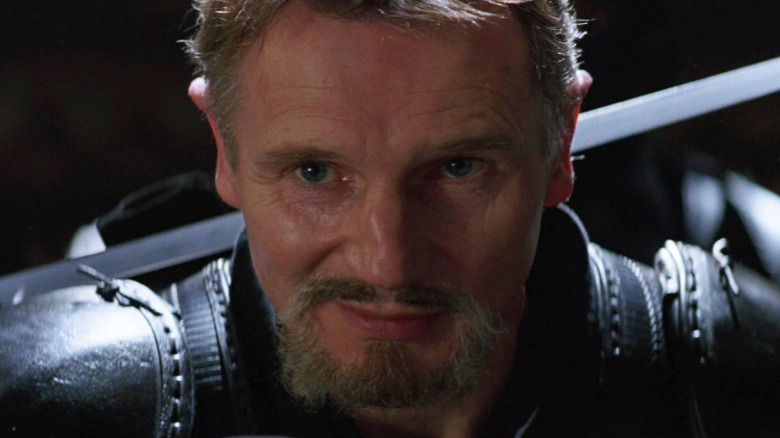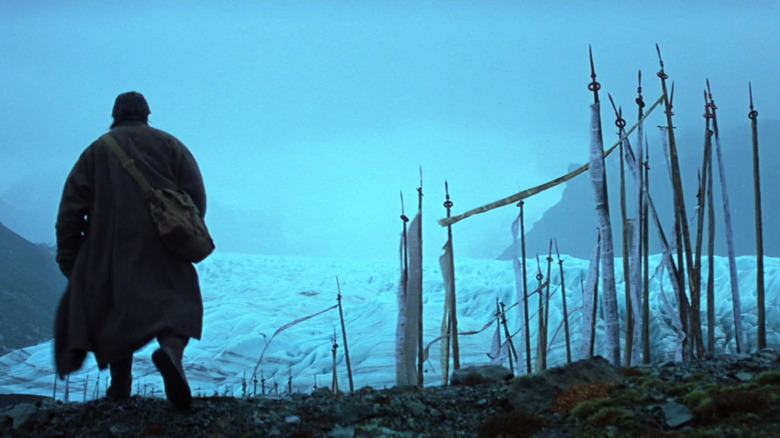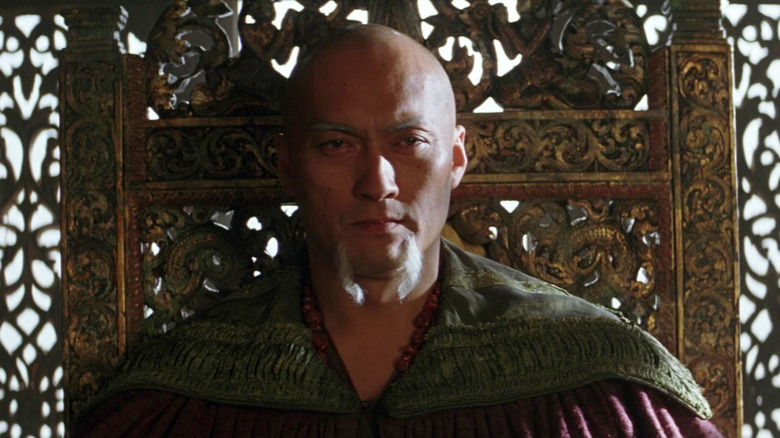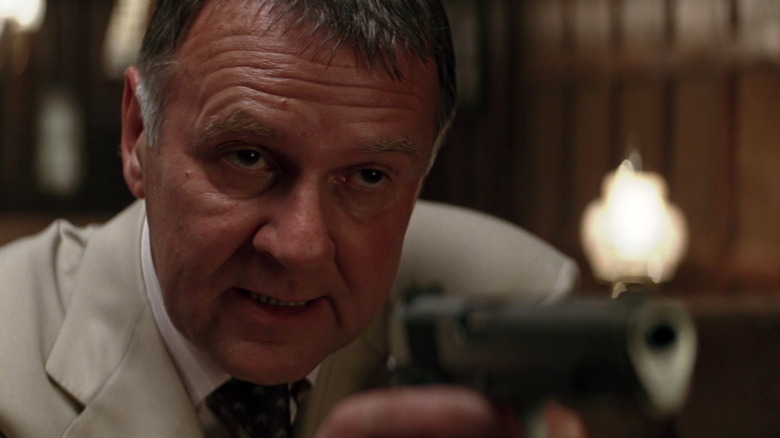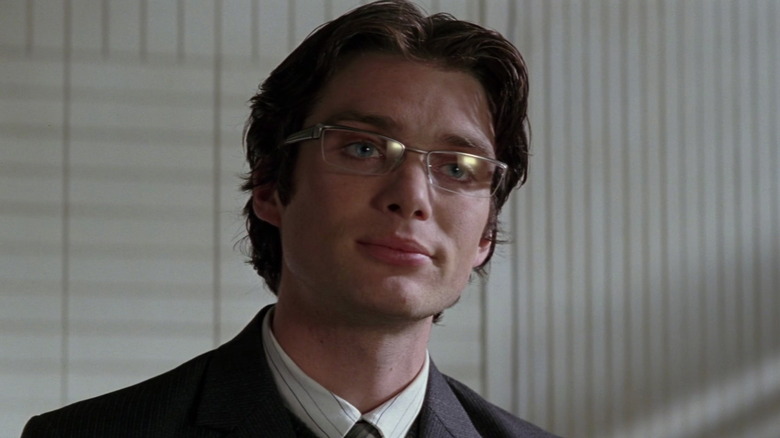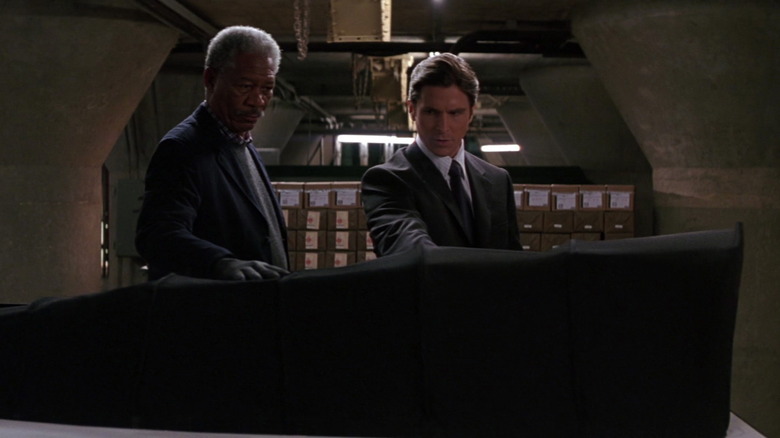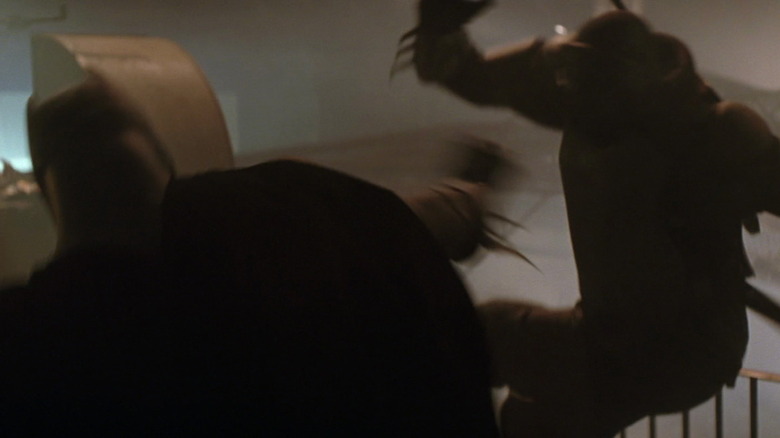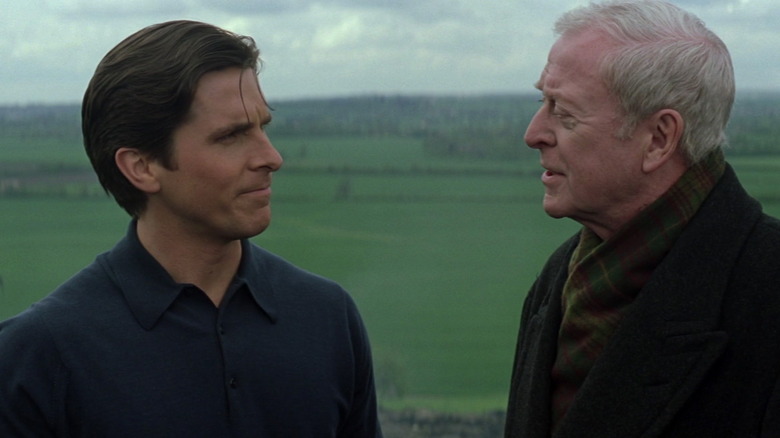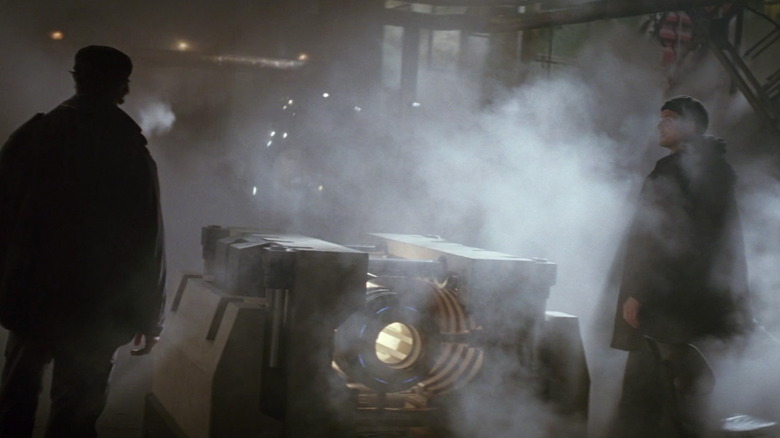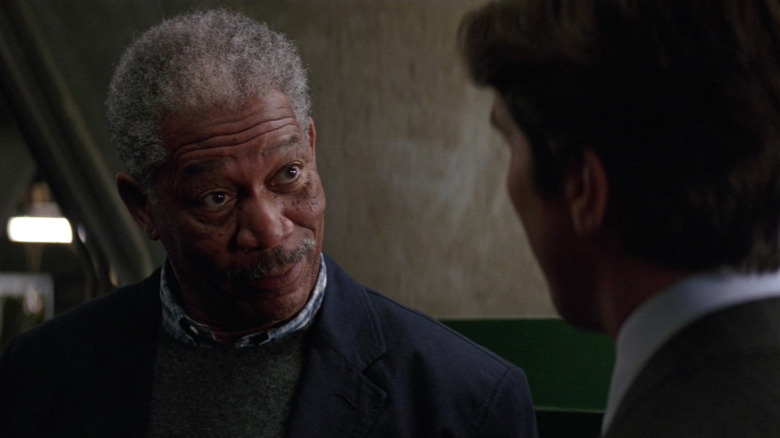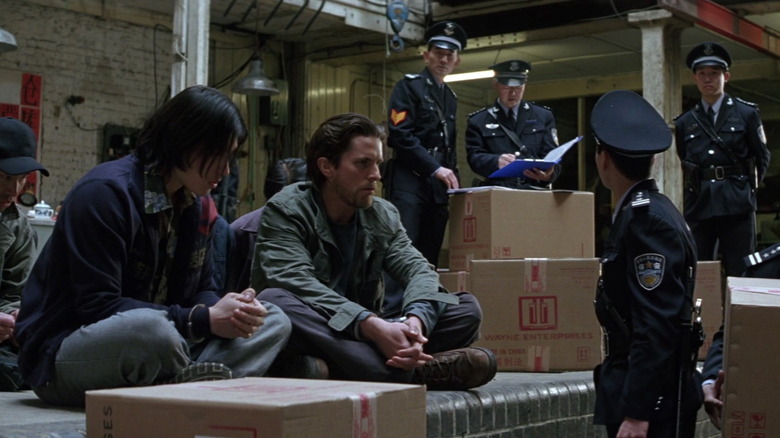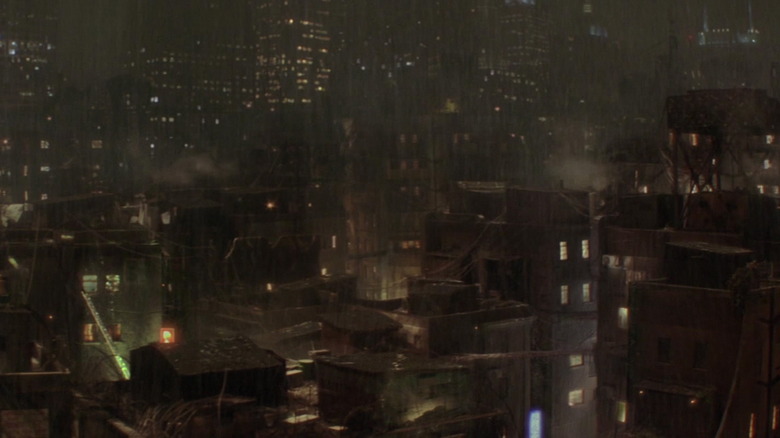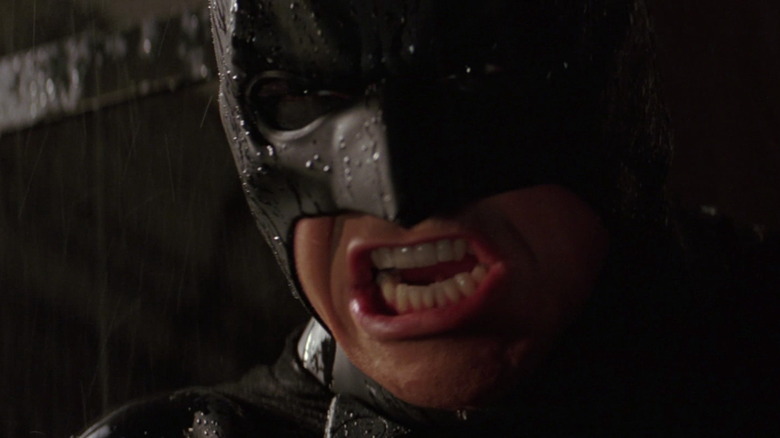The 6 Best And 6 Worst Things In Batman Begins
It's been almost two decades since the release of Christopher Nolan's "Batman Begins," a bold reboot of the Batman franchise that was, by the standards of superhero films in 2005, a shockingly grounded and somber affair. The film was a smash success, both critically and commercially, and it undeniably left its mark on superhero cinema. Gone were the days of Arnold Schwarzenegger making ice puns and George Clooney flashing a credit card with a Bat-logo on it. "Batman Begins" was a serious superhero movie that helped pave the way for the rise of superhero films that has lasted up until our present day.
Though well-received upon release, "Batman Begins" is also generally not as well-regarded as its two sequels, "The Dark Knight" and "The Dark Knight Rises." Is this reputation deserved? Is "Batman Begins" really one of the franchise's lesser entries? Today, we're taking a retrospective look at "Batman Begins" and digging into everything good and everything bad about the first chapter of this iconic trilogy. With no shortage of hindsight, here are the six best and six worst things in "Batman Begins."
The best: a great opening
Superhero origin films have a reputation for starting sluggishly. We meet a hero during an unremarkable day of their mundane life, and it will sometimes take half an hour or so before anything "super" happens. "Batman Begins," however, has a great opening that introduces us to billionaire playboy Bruce Wayne in circumstances that no audience member could have possibly predicted.
After a brief childhood flashback, we're introduced to adult Bruce. He's dirty, bearded, and currently residing in a prison in Bhutan. We soon learn that Bruce Wayne wants to be a crimefighter, but he believes that he's not up to the task yet. Ergo, he's gone to the other side of the world to train in martial arts and live among criminals in the hopes of understanding them better.
It's a compelling and dramatic situation set in some beautifully snowy environs. Also, the fact that we know so little about how and why Bruce Wayne got here creates a sense of mystery. When we eventually see some longer flashbacks to Bruce's past, they feel like answers to an intriguing mystery rather than clunky exposition. And since they're sprinkled throughout the film in brief fragments rather than in one overwhelming chunk at the beginning, the start of the film has more room for cool set pieces. Less than 20 minutes into the movie, our hero is already in a swordfight with Liam Neeson on a frozen lake; something all movies could use more of.
The worst: a misused Ken Watanabe
Early on in the film, Bruce Wayne's mentor Ducard introduces him to the alleged leader of the mysterious League of Shadows: the steely-eyed Ra's al Ghul, played by Ken Watanabe. At first, this seems like an inspired bit of casting. Watanabe is a powerhouse actor who has played countless iconic characters over the decades in both Japanese and American films, and Ra's al Ghul is one of Batman's most iconic foes. That's why it's somewhat disappointing when this character is unceremoniously killed off during the film's first half-hour. Later, Ducard is revealed to be the real Ra's al Ghul.
In some ways, it's a pretty cool plot twist. Ducard and Bruce have become friends, so this reveal adds an extra dimension of emotional complexity to their later battles. However, it's arguably a pretty racist bit of writing to make the leader of this ostensibly Asian order of assassins secretly a white man, and it's far from the first time this sort of thing has happened in a film. There's a longstanding trend in Hollywood of white characters transplanted into foreign cultures and proceeding to become the greatest warriors and leaders of those cultures. That's the plot of "Dances with Wolves," "The Last of the Mohicans," and numerous other films.
It's such a widespread problem that this isn't even the first time Watanabe's found himself in this position. He also plays second fiddle to a white foreigner in the Tom Cruise vehicle "The Last Samurai." Neeson is excellent as Ra's al Ghul, but it's disappointing how the film does Watanabe dirty.
The best: an exploration of fear
One way that "Batman Begins" distinguishes itself from other Hollywood blockbusters is in its surprisingly deft use of themes — deeper messages that recur throughout the story that go beyond the literal plot. There are several themes in "Batman Begins," but the most richly explored one is probably best summarized as "fear is a powerful force which can be wielded as a powerful weapon."
We see the first hints of this theme when young Bruce falls into a well and is attacked by a swarm of bats, leading him to develop a fear of bats. Later, when the Waynes attend a play, the dancers remind Bruce of swarming bats, so he asks his parents to leave. This leads to the family's fateful trip when Thomas and Martha Wayne are mugged and killed not far from the theater. These deaths happen, in Bruce's mind, because of his fear. If that weren't enough, the last thing Bruce's father says to him is "Don't be afraid."
Later, when Bruce gets his earliest inklings of crimefighting, he confronts the mob boss Carmine Falcone to demonstrate that not everyone in Gotham is afraid of him. Falcone responds by drawing a gun and claiming that he could shoot Bruce right then and there, in public, and no one would stop him. "That's the power of fear," explains Falcone. Bruce realizes that Falcone's power lies in the fear his persona inspires in others. Bruce decides that he is going to do the same — create an alter ego that criminals will fear. This is why he picks a bat as his symbol; It's the thing he fears most.
The worst: an underwhelming Scarecrow
Jonathan Crane is one of Batman's most terrifying foes. He's an evil psychologist who uses weaponized drugs that give his victims vivid hallucinations of their worst fears. Considering that the weaponization of fear is a recurring motif in this film, you'd think the Scarecrow would be a central part of the film's climax. But for some reason, "Batman Begins" totally drops the ball with this character.
We know that Bruce was paralyzed by fear as a child. He mostly overcame these fears on his route to becoming Batman, but a master of terror like the Scarecrow might figure out how to exploit Bruce's old fears and crank them up to a whole new level. One would think that, in order to defeat this foe, Batman would have to battle his inner demons in a climactic nightmarish fight scene after Crane hits him with some fear gas. There's just one problem ... this never happens. Sure, Batman inhales some fear gas partway through the film and briefly experiences some hallucinations. But shortly after, he takes an antidote and he's totally fine. The last time we see the Scarecrow, he runs away screaming from Rachel Dawes after she hits him with a taser.
Compare this to how the character is used in the video game "Batman: Arkham Asylum." Several times throughout the game, Batman gets dosed with fear gas and finds himself in a surreal dream world. His memories and fears blend together with reality as a Godzilla-sized version of the Scarecrow looms overhead. We know that Nolan is a fan of dreams. For Pete's sake, he's the guy who directed "Inception." There was so much more that could have been done with the Scarecrow and his abilities. It's a shame we didn't get more.
The best: delightful gadgets
One of the most unexpectedly fun things about "Batman Begins" is how granular the film gets about slowly introducing and explaining each iconic piece of Batman's costume and utility belt. His armor is a military prototype that's almost completely bulletproof, but it was deemed too expensive to manufacture on a large scale. His cape is made of an experimental memory fabric that takes a pre-programmed rigid shape when exposed to an electrical current, allowing it to function like a parachute. His "Batmobile" is an armored car with the ability to jump without a ramp, originally designed to help with rapid construction of bridges.
You might think such a relatively vast quantity of minutiae would be boring, or that explaining how all the gadgets work would make them less cool. But it's just the opposite. Because the film takes the time to explain why all these gadgets were created and how they function, they all feel tremendously grounded and tactile. For instance, when Batman fires his grappling gun, rather than relying on pure arm strength to carry him, he attaches the cable to his belt before ascending to distribute his weight better. There are wonderful small details like that with every one of these gadgets, which makes them all feel plausible and attainable in a world that's just a hair beyond our current reality.
The worst: incomprehensible fight scenes
One of the only strikes against "Batman Begins" is how it handles fight scenes. During most of the movie, the cinematography and editing are perfectly competent, but the film suddenly starts exhibiting all the worst sins of early 2000s action filmmaking whenever a fight breaks out. The camera is too close; there are too many quick cuts, and the continuity from one shot to the next is all over the place. The end result is the story of any given fight is practically impossible to follow. You just have to sit and wait until all the blurs stop moving so that you can discover who won and who lost.
The only times when this borderline indecipherable rapid cutting kind of works are the sequences when Batman ambushes criminals from the shadows. This is because when viewers can't tell what's going on, it puts them in the mindset of Batman's surprised and confused prey. However, when Batman is supposed to be on equal footing with his opponents, it's an absolute nightmare to try to figure what on Earth is happening and what is important on a moment-to-moment level.
The best: practically flawless casting
One of the most consistent delights throughout the film is the A-list cast. Everyone is completely suited to their roles and does an excellent job bringing Christopher Nolan and David S. Goyer's script to life.
Christian Bale does a pitch-perfect job as both halves of the Caped Crusader. The one thing that people mock about his performance in these films is his whispery and growly Batman voice. However, Bale's whisper-growl is far more understated and selectively deployed in "Batman Begins" than in the sequels where Bale is constantly whisper-growling with maximum intensity.
Michael Caine is fantastically charming as Bruce's butler and surrogate father, Alfred Pennyworth. Morgan Freeman is instantly captivating and endearing as the brilliant Lucius Fox. Cillian Murphy does a great job in his interpretation of the Scarecrow as a shy little creep. Liam Neeson plays Ra's al Ghul as the ultimate evil distinguished gentleman. Gary Oldman is obviously perfectly suited to his role as Jim Gordon, even if he doesn't have much to do in this particular film.
Sadly, the only actor who fails to make a lasting impression is also the only woman in the main cast, Katie Holmes. She's fine, but never more than fine. Then again, much of the blame for this might lie with the script, as she's not given a terribly interesting or rewarding role.
The worst: logic that barely holds together
Christopher Nolan movies are like a good magic trick. They dazzle you with showmanship to make sure you don't look too closely at exactly how everything works. However, that also means that if you watch his films over and over again, you start to notice little things about their underlying logic that don't totally add up.
The most glaring example of this in "Batman Begins" is everything relating to the microwave emitter. We're told that this somewhat literal plot device uses microwaves to vaporize water. But how exactly does it work? When it's first used in the film, it's on a boat full of people. The water in the surrounding pipes evaporates, but the nearby people are apparently unharmed, even though human beings are full of water. The water in the surrounding ocean also appears unaffected.
Towards the end of the film, things get even shakier when we learn that the Scarecrow has been pouring fear chemicals into the Gotham water supply for weeks. No one has felt the effects yet, we're told, because the drugs need to be absorbed through the lungs. Obviously, this is what the League of Shadows needs the microwave emitter for, but are we supposed to believe that no one in Gotham has heated up any water for the past few weeks? No one made pasta? No one took a hot shower?
Endlessly pointing out plot holes in every film you watch is a surefire recipe for becoming a total stick in the mud that no one wants to hang out with. But if you like to have a little fun now and again by poking some holes in films, "Batman Begins" is one that's quite vulnerable to such hole-poking endeavors.
The best: just the right amount of dry humor
"Batman Begins" generally presents itself as a fairly serious portrayal of the Dark Knight, with more realistic gadgets, less outlandish costumes, and far fewer silly jokes than earlier incarnations. That being said, this film still realizes that there can be immense power in occasionally cutting the tension with some well-timed humor.
Most of these jokes come through Bruce's interactions with Lucius Fox and Alfred. For instance, after Lucius shows Bruce a suit of high-tech infantry armor that is practically bulletproof, Bruce says he wants to borrow it "for spelunking." Lucius responds incredulously by asking if Bruce is "expecting to run into much gunfire in these caves?" Another example comes in the aftermath of a fight between Bruce and Ra's al Ghul that leaves Wayne Manor in flames. A beam from the ceiling falls and pins Bruce to the ground. As Alfred rushes in to help him lift it, he asks, "What is the point of all those pushups if you can't even lift a bloody log?"
Overall, it's still a very dark story and the film thankfully avoids quipping during its big climactic fight scenes. But during the more relaxed sections of the story, the filmmakers know that loosening up and having a little fun can be a welcome change of pace. The jokes come so infrequently that, at times, you almost forget the movie can be funny until it once again surprises you with the perfect dry one-liner.
The worst: muddled musings on crime
Early on, "Batman Begins" unambiguously asserts that the root cause of crime in Gotham is poverty. Bruce Wayne even says, "The first time I stole so that I wouldn't starve ... I lost many assumptions about the simple nature of right and wrong." Later, Ra's al Ghul echoes this sentiment with the observation, "Create enough hunger and everyone becomes a criminal." It's genuinely refreshing to see a superhero movie that presents crime as a symptom of deeper societal problems, rather than the actions of inherently evil people. So, that said, what's the film's solution to this problem?
If you're Bruce Wayne, apparently you just forget about all the stuff you said you learned about poverty and hunger and simply beat up criminals and corrupt cops, one by one, until the crime stops. Look, we don't need to spend the whole movie talking about it, but if you're going to acknowledge that the big problem in Gotham is poverty, could we have a line or two of dialogue where we get a sense that, by day, Bruce Wayne is also putting some resources towards that?
If the film was just a stylized adventure where Batman fought wacky supervillains, this wouldn't be a problem. The issue is that the film wants to have it both ways. It wants to be a realistic Batman movie for grown-ups that explores the actual causes of real crime. But then the movie doesn't follow through on its own promises. By the end of the story, it's yet another simplistic narrative of good guys versus bad guys. Fortunately, there's now a more recent reboot that does a far better job of making a Batman movie that talks about real-world poverty and crime — "The Batman" from 2022.
The best: an appropriately gloomy atmosphere
Though the Nolan Batman films aren't exactly known for their wildly imaginative aesthetics, "Batman Begins" features a far wider array of environments than what you'll see in its more visually grounded sequels. The opening sequence set in the Himalayas is full of gorgeous frozen scenery, even while it was actually filmed in the U.K. and Iceland. Although the version of Gotham we see in this film is mostly mundane, it still features a few well-chosen pieces of architecture, such as the Senate House in London and the Board of Trade Building in Chicago.
In some of the film's totally invented environments, such as Ra's al Ghul's monastery and the Gotham Narrows, the filmmakers got rather inventive with how they constructed these spaces, using a mixture of old-school practical models, actual landscapes, and computer trickery to push these locations just a half-step beyond reality. The city might not look nearly as fantastical as it does in the Burton and Schumacher movies, but for this first film, Nolan's Gotham is still artfully grim.
The worst: a bad precedent
Perhaps the worst thing you can say about "Batman Begins" is for decades after its release, every film was trying to be "Batman Begins" in the worst way possible.
Many of Nolan's worst habits as a director are already present here in small doses, and they only get more pronounced over time. "Batman Begins" is a bit cold and prioritizes action over emotion. From here, Nolan's movies go on to get even colder and more focused on big action set pieces. "Batman Begins" is a bit convoluted and nonsensical at times. From here, Nolan's films get even more labyrinthine in their plotting. Nolan's an amazing director, but he also has his faults, and the wild success of "Batman Begins" might have contributed to him becoming so increasingly self-indulgent and blind to his shortcomings that he'd eventually make 2020's "Tenent" — a cold, ludicrously convoluted film that hinges entirely on its big action set pieces.
It's also possible to draw a direct line from this film to everything bad about the later Zack Snyder era of DC films. With their achronological storytelling, gray color palette, cynical attitude, and extra violent action scenes, it's clear that these later DC movies desperately want to be Nolan's Batman films. Unfortunately, they learned all the wrong lessons about why the Dark Knight Trilogy is truly great.
